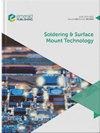Solder void size reduction in semiconductor package by vacuum reflow and pressure cure processes
IF 1.8
4区 材料科学
Q3 ENGINEERING, ELECTRICAL & ELECTRONIC
引用次数: 3
Abstract
Purpose Semiconductor packaging industry has in recent years tightened the tolerance criteria for acceptable solder void size in the semiconductor packages due to the high usage in automotive applications. Semiconductor packaging component makers have strengthened the quality of the solder joint and its electrical conductivity by controlling the maximum solder void size reduction from 10-15% to 5% or below over die size. This paper aims to reduce the solder void size to minimum level that current industry could not achieve and introduce a new soldering processes by combining vacuum reflow and pressure cure to effectively reduce solder void. Design/methodology/approach This study is using the empirical data collection to prove the feasible in achieve the goal. It is an engineering approach. This research study is even considering sufficient data (>22 units) in each evaluation to represent the actual performance. Findings Successfully eliminate all the hollow solder void that current industry claimed as solder void. EDX analysis showed that the compressed solder voids remained in the solder are filled with solid carbon-based substances which could be originated from the trapped flux residues. It is empirical data proven in feasibility stage. Research limitations/implications The study is able to produce solder void-less. This method is suitable for high volume manufacturing process also. This may lead a new pave way for industry to resolve solder void problem. The current pressure cure machine could not apply more than 200°C temperature which limits medium and high temperature solder paste or alloy testing. Therefore, only low temperature solder alloy Pb37Sn63 was able to be evaluated. Originality/value This study is original and has not been published elsewhere to produce high efficiency product in semiconductor packaging performance in electrical path and heat dissipation. It also improves package reliability due to solder joint used as interconnect in semiconductor packaging.通过真空回流和压力固化工艺减小半导体封装中的焊料空隙尺寸
目的近年来,由于在汽车应用中的广泛使用,半导体封装行业已经收紧了半导体封装中可接受焊料空隙尺寸的公差标准。半导体封装元件制造商通过控制最大焊料空隙尺寸从晶粒尺寸的10-15%减小到5%或更低,增强了焊点的质量及其导电性。本文旨在将焊料空洞的尺寸降低到目前行业无法达到的最小水平,并引入一种新的焊接工艺,将真空回流和压力固化相结合,以有效地减少焊料空洞。设计/方法论/方法本研究使用经验数据收集来证明实现目标的可行性。这是一种工程方法。这项研究甚至在每次评估中都考虑了足够的数据(>22个单位)来代表实际表现。Findings成功消除了当前行业声称为焊料空洞的所有空心焊料空洞。EDX分析表明,残留在焊料中的压缩焊料空隙被固体碳基物质填充,这些物质可能来源于捕获的焊剂残留物。这是在可行性阶段证明的经验数据。研究局限性/含义该研究能够产生较少的焊料空隙。这种方法也适用于大批量生产过程。这可能为行业解决焊料空洞问题开辟一条新的道路。目前的压力固化机不能施加超过200°C的温度,这限制了中高温焊膏或合金测试。因此,只能评估低温焊料合金Pb37Sn63。独创性/价值这项研究是原创的,尚未在其他地方发表,以生产半导体封装中的高效产品,在电路和散热方面的性能。由于焊点用作半导体封装中的互连,它还提高了封装的可靠性。
本文章由计算机程序翻译,如有差异,请以英文原文为准。
求助全文
约1分钟内获得全文
求助全文
来源期刊

Soldering & Surface Mount Technology
工程技术-材料科学:综合
CiteScore
4.10
自引率
15.00%
发文量
30
审稿时长
>12 weeks
期刊介绍:
Soldering & Surface Mount Technology seeks to make an important contribution to the advancement of research and application within the technical body of knowledge and expertise in this vital area. Soldering & Surface Mount Technology compliments its sister publications; Circuit World and Microelectronics International.
The journal covers all aspects of SMT from alloys, pastes and fluxes, to reliability and environmental effects, and is currently providing an important dissemination route for new knowledge on lead-free solders and processes. The journal comprises a multidisciplinary study of the key materials and technologies used to assemble state of the art functional electronic devices. The key focus is on assembling devices and interconnecting components via soldering, whilst also embracing a broad range of related approaches.
 求助内容:
求助内容: 应助结果提醒方式:
应助结果提醒方式:


